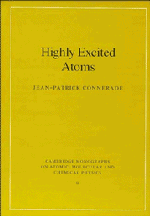Book contents
- Frontmatter
- Contents
- Preface
- 1 Closed shells, sphericity, stability and ‘magic numbers’
- 2 Rydberg states
- 3 Quantum defect theory for bound states
- 4 Atomic f values
- 5 Centrifugal barrier effects
- 6 Autoionisation
- 7 Inner-shell and double-excitation spectra
- 8 K-matrix theory of autoionising resonances
- 9 Atoms in strong laser fields
- 10 Statistical methods and ‘quantum chaology’
- 11 Atomic effects in solids
- 12 Atomic clusters
- References
- Index
10 - Statistical methods and ‘quantum chaology’
Published online by Cambridge University Press: 19 September 2009
- Frontmatter
- Contents
- Preface
- 1 Closed shells, sphericity, stability and ‘magic numbers’
- 2 Rydberg states
- 3 Quantum defect theory for bound states
- 4 Atomic f values
- 5 Centrifugal barrier effects
- 6 Autoionisation
- 7 Inner-shell and double-excitation spectra
- 8 K-matrix theory of autoionising resonances
- 9 Atoms in strong laser fields
- 10 Statistical methods and ‘quantum chaology’
- 11 Atomic effects in solids
- 12 Atomic clusters
- References
- Index
Summary
Introduction
A system is considered as chaotic in classical mechanics if the orbits, instead of remaining confined to a specific region, invade the whole of available phase space. A simple example is a pendulumn with a magnet below the bob: if a sheet of paper is placed between the magnet and the bob and a pen is attached, the pendulumn will write all over the page within the range accessible to it. More exactly, if we examine phase space, it will seem completely disordered, with interwoven tracks throughout its volume. If we magnify the volume, the disorder will persist, and so on ad infinitum no matter how great the magnification, because classical mechanics imposes no limit on the resolution which can be achieved.
Chaotic behaviour can arise in any system whose motion is described by a nonlinear differential equation. Whether or not it is prevalent depends on the details of the problem, but it is a general theorem that any system described by a nonlinear differential equation possesses some chaotic regime.
In quantum mechanics, by contrast, chaos does not occur. We may see this in several ways. First, note that we cannot magnify ad infinitum the volume to be analysed in phase space: eventually, we reach the elementary volume ħ3 within which trajectories lose their meaning. Another way of reaching the same conclusion is to note that any Schrödinger type equation is linear: its solutions obey the superposition theorem. Under these circumstances genuine chaos is excluded by fundamental principles.
- Type
- Chapter
- Information
- Highly Excited Atoms , pp. 363 - 402Publisher: Cambridge University PressPrint publication year: 1998



